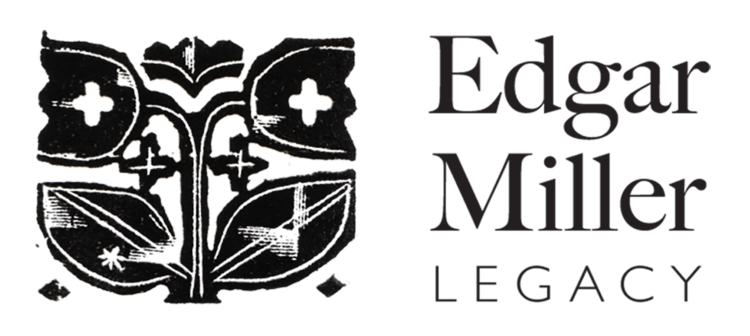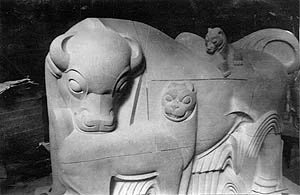Animal Court
National Public Housing Museum
formerly Jane Addams Homes
Chicago, Illinois
1937
Sculpture garden
Built in the midst of the Great Depression, the Jane Addams Homes was the first public housing project in Chicago. At its center was a beautiful courtyard and fountain decorated with a collection of monumental animal sculptures conceived and designed by Edgar Miller. Done in a modernist art deco style with Miller’s signature flourishes, these sculptures were recently restored by the National Public Housing Museum (NPHM) and have been incorporated into a new courtyard onsite at 919 S. Ada St. NPHM educates about the stories of what it was like to live and grow up in the revolutionary Jane Addams Homes from its earliest residents all the way through the demolition of the project in the 2000s.
Jane Addams Homes— completed in 1937 and named after the late social worker and reformer— was funded by the Works Progress Administration (WPA), an initiative of the New Deal, which was implemented to help the United States dig its way out of the Great Depression. Beyond building large works projects like apartments, roads, dams and electric grids, the federal government also saw the value in funding art projects for government buildings as a way to provide relief to struggling artists all over the country. The main agency in charge of planning and allocating the money for federal art projects was the Temporary Relief for Artists Program (TRAP).
The architecture firm Holabird & Root was hired to design the Jane Addams Homes and due to their longstanding relationship with Edgar Miller they suggested him to the federal administrators as the perfect artist to create the art for their innovative apartment project. Miller’s designs were used by a team of artisans and workers to create the iconic sculptures known as Animal Court.
Miller loved to employ lively animals figures in his art. He believed that living creatures were a reflection of nature and that their expression helped viewers to get in touch with nature and their most basic humanity. Since the sculpture garden was intended to be accessible to the housing project’s children, it made even more sense to use animals as a way to engage the young minds of the neighborhood.
The design work for the sculptures took some time as Miller was preoccupied with many other projects and responsibilities. NPHM researched and discovered documentation of the back-and-forth exchanges between many government officials, the architecture firm, the stone supplier, the sculpting firm, and Edgar Miller during a period of years before the project was completed. A determined cordiality and familiarity pervades most these letters, even getting into discussions about the philosophical nature of the project and academic theories about public art.
Original sketch of Animal Court and Edgar Miller’s notes, c. 1936, courtesy of the National Public Housing Museum.
One of the major points of contention was whether to use union labor in the execution of the sculptures. Edgar wanted to sculpt them himself, but since the WPA insisted that all construction be on site and done by 100% union labor, a workaround had to be found. The architects and government officials conceded that the sculpting would need to be done by a skilled non-union artisan. After some deliberation, a company run by Charles Buhl was chosen and the union leaders agreed to let the work be done by non-union artisans as long as the sculptures were executed off-site. This added considerable moving expenses to the project’s cost, but it also staved off any labor unrest on the project site.
By the summer of 1937 the Animal Court sculptures were completed. It took three months to sculpt all of the sculptures, which consisted of six boulder-like animals of about 3 feet in height and one taller sculpture of a cow and several cats of nearly 7 feet in height. According to public housing researcher Elizabeth Milnarek, the large sculpture of the bull and cats had its final conception redesigned by an apprentice of Miller’s named Emmanuel Viviano. Thus, it is difficult to distinguish between their styles and it’s clear that Miller’s influence was profound.
The Jane Addams Homes opened in 1938, and Animal Court was a smashing success. Not only were the sculptures fun for children to climb on top of and play make-believe but there was also an innovative reflecting pool and sprinkler system that ran through the center of the sculpture garden, providing much-needed relief from the heat in the summer months.
Over the subsequent decades, the sculptures would become weathered and discolored, and government support for public housing began to wane by the 1960s. However, the residents of the apartments took care of Animal Court, repainting the animals from time to time to protect them from the elements. Still, after nearly seventy years of exposure to Chicago’s harsh winters, by the early 2000s the sculptures were in need of serious repair.
At the same time, the Chicago Housing Authority was on a mission to wipe clear as many of these old projects as they could. The buildings had long become outdated, run down, and dangerous. NPHM secured the rights to use one remaining building of the thirty-two original Jane Addams Homes apartment buildings, and they were allowed to remove Animal Court from the site to be restored and preserved.
Deterioration and repainting could be seen on the sculptures prior to the demolition of most of the Jane Addams Home buildings and relocation of the sculptures for restoration, c. 2000.
The restored sculptures returned to their original site at the newly opened National Public Housing Museum building on Taylor Street in fall 2024.
The Animal Court sculptures were eventually fully restored and returned to decorate the east plaza entrance to the NPHM museum site in 2024. With the museum’s opening of its new main building in the spring of 2025, the full set of seven sculptures finally came home to once again be experienced and enjoyed by the public. According to the NPHM: "The Animal Court sculptures at the former Jane Addams Homes are a touchpoint not only to the Taylor Street and Little Italy neighbors, but also advocates of art everywhere. Neighbors, Chicagoans, and Americans understand the importance of art in enriching and bringing together our communities and bringing together the stories we share."
To learn more and to plan a visit to the museum site please visit: www.nphm.org.













